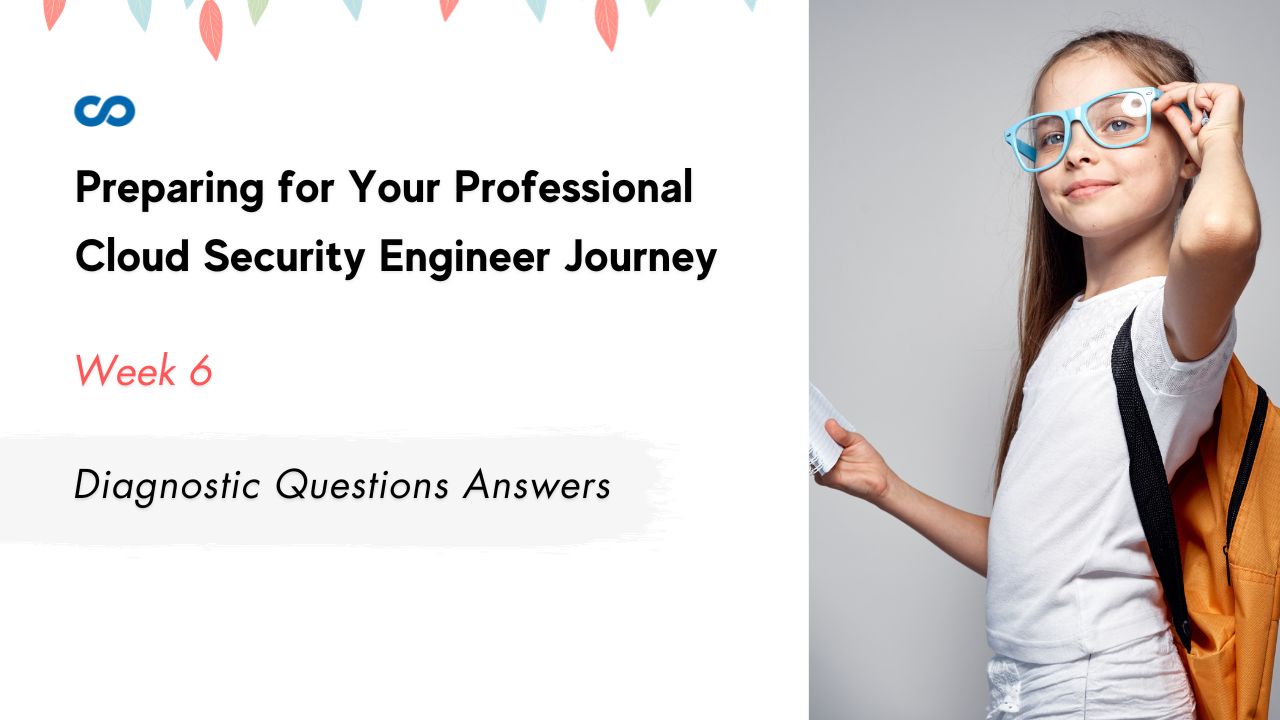Week 6 Diagnostic Questions Answers
In this article i am gone to share Preparing for Your Professional Cloud Security Engineer Journey Week 6 Diagnostic Questions Answers with you..
Enrol Link: Preparing for Your Professional Cloud Security Engineer Journey
Week 6 Diagnostic Questions Answers
Diagnostic Questions Answers
Question 1)
Cymbal Bank’s lending department stores sensitive information, such as your customers’ credit history, address and phone number, in parquet files. You need to upload this personally identifiable information (PII) to Cloud Storage so that it’s secure and compliant with ISO 27018. How should you protect this sensitive information using Cymbal Bank’s encryption keys and using the least amount of computational resources?
- Generate a customer-managed encryption key (CMEK) using Cloud KMS. Decode it as a base-64 string. Upload the blob to the bucket using this key.
- Generate an RSA key as a 32-byte bytestring. Decode it as a base-64 string. Upload the blob to the bucket using this key.
- Generate a customer-managed encryption key (CMEK) using RSA or AES256 encryption. Decode it as a base-64 string. Upload the blob to the bucket using this key.
- Generate an AES-256 key as a 32-byte bytestring. Decode it as a base-64 string. Upload the blob to the bucket using this key.
Question 2)
You are designing a web application for Cymbal Bank so that customers who have credit card issues can contact dedicated support agents. Customers may enter their complete credit card number when chatting with or emailing support agents. You want to ensure compliance with PCI-DSS and prevent support agents from viewing this information in the most cost-effective way. What should you do?
- Implement Cloud Data Loss Prevention using its REST API.
- Use customer-managed encryption keys (CMEK) and Cloud Key Management Service (KMS) to detect and encrypt sensitive information.
- Detect sensitive information with Cloud Natural Language API.
- Use customer-supplied encryption keys (CSEK) and Cloud Key Management Service (KMS) to detect and encrypt sensitive information.
Question 3)
You are a cloud engineer at Cymbal Bank. You need to share the auditing and compliance standards with your CTO that cover controls over financial reporting and both public and private controls over security, availability, and confidentiality. Which compliance standard covers this?
- FIPs 140-2
- GDPR
- SOX
- PCI-DSS
Question 4)
Cymbal Bank’s Insurance Analyst needs to collect and store anonymous protected health information of patients from various hospitals. The information is currently stored in Cloud Storage, where each hospital has a folder that contains its own bucket. You have been tasked with collecting and storing the healthcare data from these buckets into Cymbal Bank’s Cloud Storage bucket while maintaining HIPAA compliance. What should you do?
- Create a new folder. Create a new Cloud Storage bucket in this folder. Give the Insurance Analyst the ‘Editor’ role on the new folder. Collect all hospital data in this bucket. Use the Google Cloud Healthcare Data Protection Toolkit to monitor this bucket.
- Create a new Project. Create a new Cloud Storage bucket in this Project with customer-supplied encryption keys (CSEK). Give the Insurance Analyst the ‘Reader’ role on the Project that contains the Cloud Storage bucket. Use the Cloud DLP API to find and mask personally identifiable information (PII) data to comply with HIPAA.
- Create a new Project. Use the Google Cloud Healthcare Data Protection Toolkit to set up a collection bucket, monitoring alerts, audit log sinks, and Forseti monitoring resources. Use Dataflow to read the data from source buckets and write to the new collection buckets. Give the Insurance Analyst the ‘Editor’ role on the collection bucket.
- Use the Cloud Healthcare API to read the data from the hospital buckets and use de-identification to redact the sensitive information. Use Dataflow to ingest the Cloud Healthcare API feed and write data in a new Project that contains the Cloud Storage bucket. Give the Insurance Analyst the ‘Editor’ role on this Project.
Question 5)
Cymbal Bank plans to launch a new public website where customers can pay their equated monthly installments (EMI) using credit cards. You need to build a secure payment processing solution using Google Cloud which should follow the PCI-DSS isolation requirements. How would you architect a secure payment processing environment with Google Cloud services to follow PCI-DSS? (Select the two correct choices)
- Create a new Google Cloud project with restricted access (separate from production environment) for the payment processing solution. Configure firewall rules, a VPN tunnel, and an HTTP(S) load balancer for a new Compute Engine instance.
- Create a new Google Cloud project with restricted access (separate from production environment) for the payment processing solution. Create a new Compute Engine instance and configure firewall rules, a VPN tunnel, and an internal load balancer.
- Deploy a Linux base image from preconfigured operating system images. Install only the libraries you need. Deploy using Terraform.
- Deploy an Ubuntu Compute Engine instance. Install the libraries needed for payment solutions and encryption/decryption. Deploy using Terraform.
- Create a new Google Cloud project with restricted access (separate from production environment) for the payment processing solution. Configure firewall rules, a VPN tunnel, and an SSL proxy load balancer for a new App Engine flexible environment.

